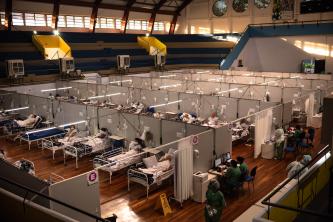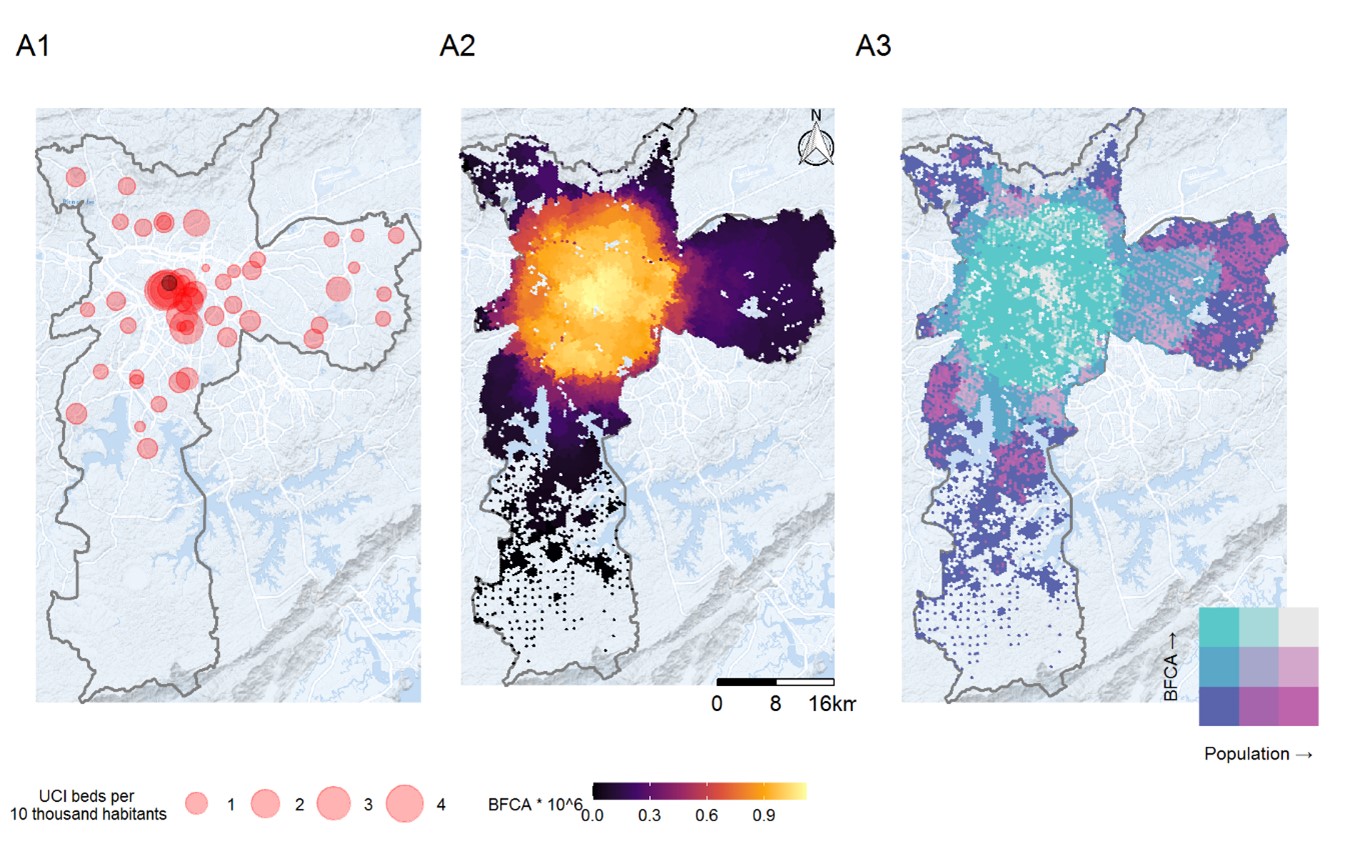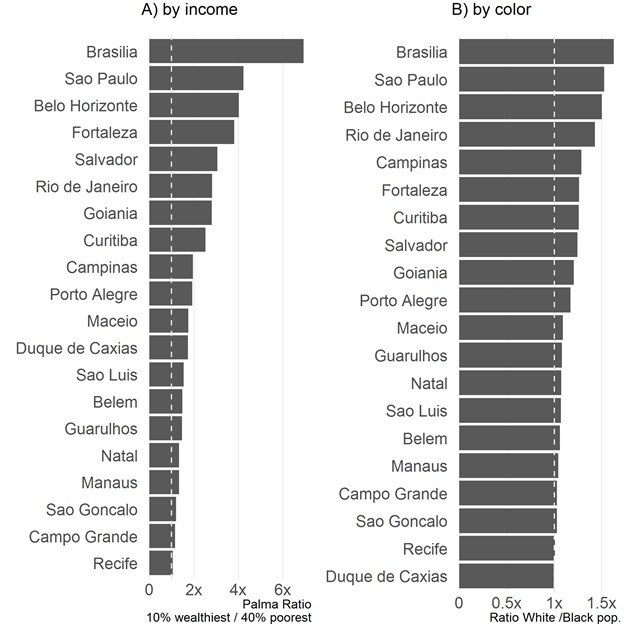
16 May 2022
Rafael Pereira sheds new light on the issues of inequalities in access to health services in Brazilian hospitals during the Covid-19 pandemic. By cross-referencing the quality of their transport accessibility with the socio-economic and demographic characteristics of the neighborhoods they serve, he suggests new directions for public policies — a methodology that European countries could learn from.
A rapidly growing number of studies have examined how human mobility patterns have influenced the spread of the COVID-19 or how the pandemic halted mobility in different countries. Much less attention has been given to issues of access to COVID-19 healthcare and to hospitals’ response capacity at the local scale, where the actual policy response occurs. Yet, the geographic accessibility to health services becomes a central concern when it comes to the differential capacity of different socioeconomic and ethnic groups in coping with the pandemic.
In a new study, recently published in Social Science & Medicine 1, we draw attention to this issue by examining the spatial, income and racial inequalities in access to COVID-19 healthcare in Brazil’s 20 largest cities. Our study also draws attention to the importance of using a new accessibility measure that accounts for competition effects given the limited availability of healthcare resources.
In Brazil, health services are considered a right and a state responsibility. Public health in the country is organized through the unified health system (SUS) created in 1990. While SUS has achieved nearly universal access to health-care services across the country, the system still faces multiple challenges due to insufficient funding and lower healthcare supply, particularly in smaller cities and less developed regions of the country 2.
Brazil is one of the countries most affected by the pandemic and known for stark levels of social inequalities. A recent study has found that low-income and ethnic minority groups in Brazil are more vulnerable to COVID-19 with higher risks of infection and mortality 3. The authors find this is largely a result of pre-existing social and health inequities. The study shows that these groups have more comorbidities, are more likely to be employed in job positions that require working in person and have lower capacity to reduce daily mobility levels and follow social isolation recommendations. Another study has also found that low-income communities living in urban fringes have lower access to COVID-19 diagnostics 4. Our new study on geographic access to COVID-19 healthcare brings new evidence that helps us understand some of these inequitable effects of COVID-19 on different social groups reported previously.
First, our study examines the support capacity of the public health system in Brazil's largest cities, looking at the number of ICU (Intensive Care Unit) beds/ventilators per person in the catchment area of each hospital. We find that that 13 out of the 20 largest cities in Brazil have fewer ICU beds/ventilators than the minimum level recommended by national authorities (1 adult ICU bed for each 10,000 people). This number has shown to be insufficient to cope with the rapid propagation of COVID-19 across many cities in the country. The situation gets aggravated when we consider how health services are spatially concentrated and how vulnerable communities historically face significant segregation issues and mobility barriers due to poor urban transport conditions.
We then mapped approximately 228,000 or 5% of the vulnerable population (low-income and above 50 years old) living more than 30 min walking from primary and emergency care units with capacity for triage and referral of patients with suspected COVID-19 to hospitals. We also found 1.6 million vulnerable people living farther than 5 km from a hospital with capacity for ICU admission. This total represents 41% of the vulnerable population in the 20 cities. These numbers vary widely across cities due to the different patterns of urban occupation and the spatial distribution of healthcare facilities in each area. Cities like Rio de Janeiro, São Paulo, Brasília, and Curitiba stand out for having more than 100,000 inhabitants in potentially vulnerable conditions and with poor access to hospitals with ICU beds and mechanical ventilators. It is also noteworthy that half of the 20 cities have more than 50% of their vulnerable population living farther than 5 km from inpatient facilities.
Table 1 - Low-income population above 50 years old with access to healthcare in Brazil’s 20 largest cities, 2020.
| City | Total population | Vulnerable population** | (A) Vulnerable Pop. with poor access to basic health services | (B) Vulnerable Pop. with poor access to ICU hospitalization | (B) / Vulnerable Pop. (%) |
|---|---|---|---|---|---|
| Rio de Janeiro | 6592.2 | 692.5 | 51.9 | 384.3 | 55.5 |
| São Paulo | 12142.6 | 1053.6 | 33.2 | 263.1 | 25 |
| Brasília | 3052.5 | 180.3 | 21.1 | 121 | 67.1 |
| Curitiba | 1927 | 172.9 | 5.1 | 116.4 | 67.3 |
| Belo Horizonte | 2469.9 | 244 | 7.2 | 92.3 | 37.8 |
| Fortaleza | 2651.8 | 193.5 | 6.5 | 77.7 | 40.2 |
| São Gonçalo | 1075.4 | 112.9 | 8.8 | 72.6 | 64.3 |
| Duque de Caxias | 905.1 | 81.3 | 13.5 | 67 | 82.4 |
| Porto Alegre | 1480.5 | 159.6 | 8.6 | 60.3 | 37.8 |
| Goiânia | 1509.4 | 118.3 | 11.4 | 59.4 | 50.2 |
| Campinas | 1208.9 | 115.1 | 12.2 | 58.1 | 50.5 |
| Guarulhos | 1389.9 | 98.7 | 4.3 | 48 | 48.6 |
| Recife | 1607 | 147.1 | 0.6 | 42.9 | 29.2 |
| Campo Grande | 895.6 | 69.7 | 5 | 42.9 | 61.5 |
| Maceió | 1042 | 74.2 | 8.4 | 38.2 | 51.5 |
| Salvador | 2831.6 | 217.4 | 7.8 | 35.3 | 16.2 |
| Belém | 1360.1 | 97.2 | 8.7 | 32.9 | 33.8 |
| Manaus | 2216.1 | 111.6 | 2.3 | 24.8 | 22.2 |
| São Luís | 1080.4 | 69.3 | 10.2 | 18.6 | 26.8 |
| Natal | 867.9 | 63 | 1.6 | 10.2 | 16.2 |
| Total | 48305.9 | 4072.2 | 228.4 | 1666 | 40.9 |
Finally, we compare accessibility inequalities across neighborhoods, income levels and racial groups using a new indicator called balanced float catchment area (BFCA) index to estimate access to ICU beds and ventilators. The BFCA is an indicator of accessibility that simultaneously account for both spatial proximity to health resources and for the potential competition for those resources. A person might live very close to a hospital, but such proximity might not guarantee good access to healthcare if that is the only hospital in the region struggling to find room for patients. The analysis using BFCA thus allows us to get a more realistic understanding of how access to healthcare is aggravated when accounting for competition effects on both supply and demand for health services. The BFCA estimates show large inequalities. Access to covid19 healthcare tend to be systematically lower in urban peripheries (Figure 1), which could more easily be overwhelmed by the near-future hospitalization demands.
Figure 1 below shows the co-distribution of population density and access to COVID-19 healthcare. Areas colored in bright cyan are areas with small population but with relatively high access to health services. In contrast, bright pink indicates places with large populations underserved by health services, and dark purple areas indicate places with small population with the lowest access to health. From a health and mobility planning point of view, bright pink and dark purple areas should probably receive great attention from public authorities with different policy strategies, for example building temporary hospitals or engaging local health community agents, because of their differences in terms of population densities.

Figure 1. Map of São Paulo showing A1) The number of ICU beds per person in the catchment area of each hospital, A2) BFCA accessibility level, A3) the combined spatial distribution of population and accessibility. The bivariate choropleth map (A3) helps draw attention to places that deserve more (or less) attention.
The geographic access to COVID-19 healthcare in Brazil presents not only spatial but also marked social inequalities. Fig. 2 shows the magnitude of the racial and income inequalities in access to ICU beds and ventilators considering competition effects. One of the most extreme cases is the capital of the country Brasília, where the number of ICU beds with ventilators accessible by the wealthiest population is more than six times larger than for the poor. While racial inequalities are relatively lower compared to inequalities by income, they are still present in most cities. This is particularly true in Brasília, São Paulo, and Belo Horizonte, where black communities can only access half as many health resources as the white population.

Figure 2. Income and racial inequalities in access to ICU beds and ventilators considering competition effects. Brazil’s 20 largest cities, 2020.
In summary, our findings point to a worrying pattern. Across Brazil's 20 largest cities, we find substantially lower healthcare system capacity in peripheral urban areas and among low-income and black communities. In particular, urban peripheries with high population density coupled with low incomes and poor sanitation services create a worrying scenario with strong potential for propagation of the COVID-19 precisely among communities that are most vulnerable to the disease and with the lowest access to healthcare. Combined, the analyses presented provide valuable information that can help local authorities map the areas which should receive more immediate response from local healthcare community agents and perhaps the construction of new field hospitals to address short-term needs induced by the COVID-19 pandemic.
Overall, the paper illustrates how transport accessibility analyses can provide actionable information to help local governments improve access to healthcare during pandemic outbreaks. By putting disadvantaged communities with poor accessibility on the map, the study helps identify neighborhoods where local authorities should prioritize building makeshift hospitals and/or engaging mobile units. These analyses may also help identify which hospitals might face greater admission overload and hence would need supplementary funding to expand capacity. The application of the novel BFCA methodology in this paper illustrates how considering competition effects in access to healthcare can have important but often overlooked implications for policy planning.
This type of research can be applied around the world, particularly in larger cities, with little data requirements. The results can support the identification of areas where the construction of makeshift hospitals would be more effective to improve healthcare accessibility, particularly for vulnerable groups, making cities and health systems more resilient for future pandemics.
1 https://doi.org/10.1016/j.socscimed.2021.113773
2 https://www.thelancet.com/journals/lancet/article/PIIS0140-6736(19)31243-7/fulltext
3 http://dx.doi.org/10.1136/bmjgh-2021-004959
4 https://doi.org/10.1038/s41562-020-0928-4
5 https://www.sciencedirect.com/science/article/pii/S0277953621001052?via%3Dihub#bib42
6 https://www.sciencedirect.com/science/article/pii/S0277953621001052?via%3Dihub#bib18
For the Mobile Lives Forum, mobility is understood as the process of how individuals travel across distances in order to deploy through time and space the activities that make up their lifestyles. These travel practices are embedded in socio-technical systems, produced by transport and communication industries and techniques, and by normative discourses on these practices, with considerable social, environmental and spatial impacts.
En savoir plus xPolicies
Theories

Southern Diaries by Forum Vies Mobiles are licensed under a Creative Commons Attribution-NonCommercial-ShareAlike 3.0 France License.
Permissions beyond the scope of this license may be available at contact.
Other publications